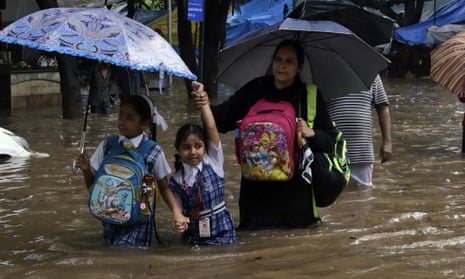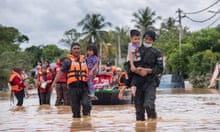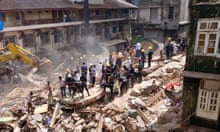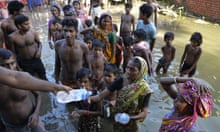As torrential rain pounded Mumbai this week, Radha Rajput was where she always is: on the pavement between railway tracks and a main road.
The streets of India’s financial capital are her home and have been for the past 50 years. She and her son, his wife and their one-year-old twins have endured the challenges of seasonal rain and scorching summer heat for decades, but this downpour was a fresh nightmare.
“We have been sitting and sleeping on these steps, because they are a bit higher up, for days now,” said Rajput, as her daughter sat behind her picking lice out of her hair. “We can’t cook, there is no clean drinking water. The water was up to our waist. Not a single thing was dry. The rich are OK, but we’re out here with nothing.”
Devastating rainfall across South Asia has led to the deaths of more than 1,200 people and directly affected more than 40 million people in northern India, southern Nepal, northern Bangladesh and southern Pakistan.
About 60% of Mumbai’s 20 million residents live in slums, which gives the city its nickname “Slumbai”. The 2011 Indian census put the number of homeless people in Mumbai at just over 57,000, but local activists say it is more like 150,000-300,000.
As the flood waters began to ebb on Friday, the impact of the disaster on rich and poor people alike was beginning to emerge.
Rescuers worked overnight to pull 12 survivors from the rubble of a building that collapsed on Thursday in the densely populated area of Bhendi Bazaar, killing 34 people.
The 117-year-old, six-storey building had been declared unsafe by the housing regulator in 2011, but many people continued living there. A 20-day-old baby was reported to be among the dead.
Dr Deepak Amarapurkar, 59, a senior gastroenterologist at Bombay hospital, was also among the victims of the extreme weather. He had decided to walk the 10-minute journey through the flooded roads on Tuesday to his home, despite his colleagues advising him to wait until the waters had receded.
On the way, he fell into an open manhole. Onlookers tried to pull him out, but were only able to retrieve his umbrella. Locals said they had removed the manhole lid to help the water level go down. His body later washed up on the shore at Worli, nearly 2.5 miles (4km) away.
With little government help available, some stranded Mumbaiites turned to social media to connect with people willing to put them up for the night.
Mehul Ved, a software professional, created a spreadsheet listing those offering assistance. By Thursday, it contained the names of 6,500 people prepared to help strangers with food, shelter and a change of clothes.
But for those living on the streets, there were no offers of shelter, said Brijesh Arya, the founder of Pehchan, an organisation that supports Mumbai’s homeless families. He said the community kitchens, government help, and shelter provided by churches, temples and some shopkeepers, were reserved for better-off residents.
“The homeless got nothing,” said Arya. “They stayed in the same wet clothes for days. The rains have devastated this vulnerable community. I can’t forget the words of one woman who said to me ‘Just bring me poison will you, I want to die,’ because she couldn’t cope.”
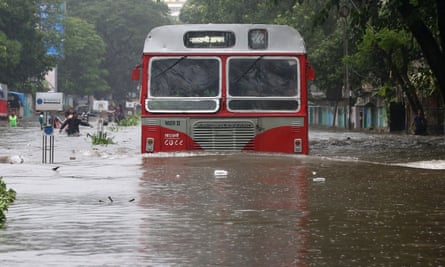
That woman was Savita Kharve, 45, who was born on the streets of Mumbai and lives with her family on the pavement near Mumbai Central railway station. When Arya visited her, he found “horrible” conditions. “No one was eating. The kids are now all sick with runny noses and coughs,” he said.
The Kharves were huddled together under plastic tarpaulin sheets, strengthened with sticks of bamboo, as makeshift protection from the monsoon rain. Gathered around them were survival essentials: a cooking stove, old clothes, second-hand toys and piles of flowers they continued to prepare to sell as soon as the rain subsided.
In a video recorded on Wednesday in the middle of a storm, Kharve told Arya that she and her children had not eaten since the flooding began. With knee-high water, there was nowhere for them to squat and chop vegetables or put down a cooking stove.
Most of the homeless families are daily-wage workers who buy food each day, a task that became impossible during the storm.
“The children went hungry,” said Kharve. “Look around you, there is nothing but water, but who cares about us? Who cares about poor people like me? We are drenched.
“I have no dry clothes. We are just standing here in the rain with nothing,” she said, pointing to her few belongings strewn on the wet and muddy pavement.
Many women and children tried to take refuge under shop awnings or in doorways, but were shooed away. “Where are they supposed to go?” asked Arya. “There are no shelters in the city and there is nowhere for them to escape to.”
